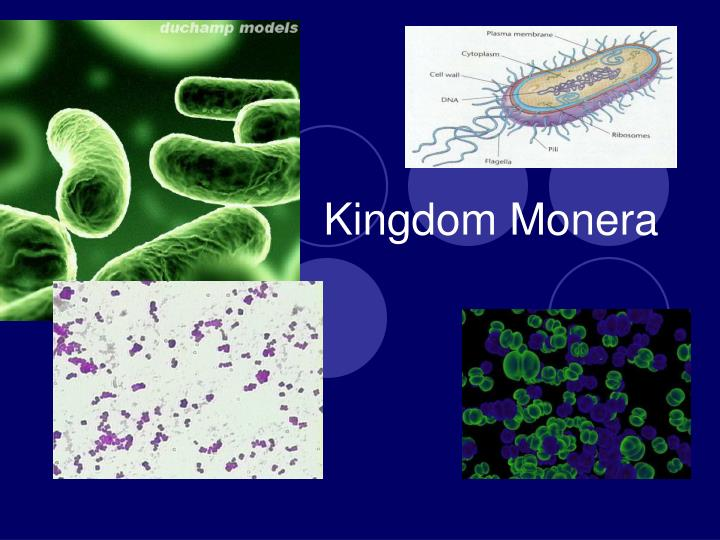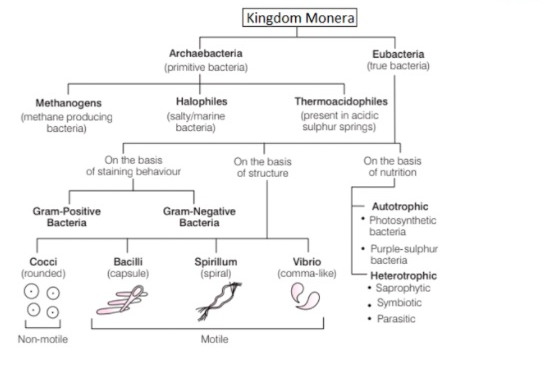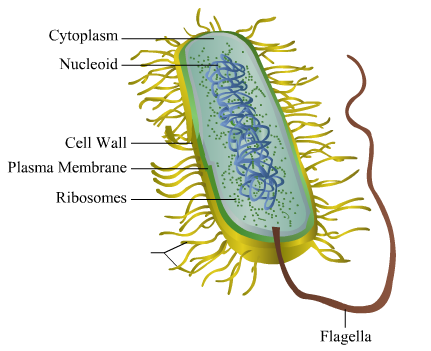All the prokaryotic organisms are classified under Kingdom Monera. Prokaryotes are organisms that are single-celled and lack a nuclear membrane. They are one of the simplest organisms in their structural arrangement but complex in their behavior.
Life forms belonging to Monera Kingdom are the most primitive organisms and are found in extreme environments including hydrothermal vents, deep oceans, hot springs, deserts, and snow.
This article will help you understand the main characteristics and classification of Kingdom Monera.

Index
Five Kingdom Classification
There have been classifications proposed by various scientists for grouping living organisms and studying them. These can be summarized as:
- Three kingdom classification system by Haeckel (in the year 1866)
- Four kingdom classification system by Copeland (in the year 1956)
- Five kingdom classification system by Whittaker (in the year 1969)
- Six kingdom classification system by Woese (in the year 1977)
Out of these the most widely accepted classification system is the 5 Kingdom classification proposed in 1969, by Robert H. Whittaker. This system is made of five different kingdoms which broadly categorize all the living organisms inhabiting Earth. It has been proposed to take into consideration these factors namely, the mode of nutrition, the structure of cells, thallus’s organization, method of reproduction, and their phylogeny. The 5 Kingdom classification system comprises:
- Kingdom Animalia
- Kingdom Plantae
- Kingdom Fungi
- Kingdom Protista
- Kingdom Monera
Classification of Kingdom Monera
Further within the 5 Kingdom classification, Kingdom Monera can be subdivided into two groups namely, Archaebacteria and Eubacteria.
Archaebacteria
The bacteria belonging to this group are characterized by a more primitive nature as compared to eubacteria, as these species are essentially the oldest living organisms on Earth. They are adapted to survive in extreme environmental conditions and can withstand stress factors. They are further categorized based on their habitat.
- Methanogens: Bacteria that can be found in the intestinal tract of living organisms and sewage.
- Thermoacidophiles: Bacteria that can be found living in hot springs.
- Halophiles: Bacteria that can be found living in extremely salty conditions (e.g. bacteria found in the Dead Sea).
Eubacteria
The bacteria categorized under this group are termed “True bacteria”. Eubacteria inhabit various environments and are widespread all over the world as a result. Their cell wall is made up of peptidoglycan. Eubacteria are further subdivided based on:
- Gram Staining: Gram-positive bacteria take up the gram stain, while gram-negative bacteria don’t.
- Structure and Shape:
- Cocci- Bacteria are spherical or oval in shape
- Bacillus- These are rod-shaped bacteria
- Vibrio- These are comma or kidney-shaped small bacteria, and
- Spirillum- These are spiral or coiled shaped.
- Mode of Nutrition:
- Autotrophic bacteria: This group includes Cyanobacteria(blue-green algae) and Chemoautotrophs. The former uses sunlight to prepare food much like plants, while the latter depends on chemical sources fro energy to prepare their food.
- Heterotrophic bacteria: These bacteria are unable to prepare their own food and instead depend on other living organisms for energy by consuming organic material.
The given below flowchart summaries the classification of kingdom Monera:

Read About: Difference Between Cell Wall and Cell Membrane
Characteristics of Kingdom Monera
The salient features of Monera are :
- They are mainly microscopic and single-celled organisms.
- They do not have a membrane-enclosed nucleus.
- The bacterial DNA is circular and naked.
- They do have membrane-enclosed organelles such as mitochondria and chloroplasts.
Ribosomes of 70S type are found in the bacterial cell. - They normally reproduce asexually.
- Bacterial cells are usually 1-10 µm in length (much smaller than eukaryotic cells).
- Most bacteria have a cell wall, the cell wall may be surrounded by a capsule.
- May have flagella and cilia for locomotion.
- The mode of nutrition is both autotrophic and heterotrophic.
- Respiration is aerobic or anaerobic. Mesosomes help in respiration.
- They are cosmopolitan in distribution.

FAQs
Kingdom Monera comprises prokaryotes which are unicellular organisms lacking a nuclear membrane. All the other four Kingdoms of the Whittaker classification comprise multicellular organisms.
Members of Kingdom Monera reproduce mainly by asexual reproduction via budding, sporulation, and binary fission. Sexual reproduction is also found in bacteria and they reproduce by the process of conjugation.
Cyanobacteria are prokaryotic organisms, meaning they lack a true nucleus whose genetic material is dispersed loosely in the cell. On the other hand, the genetic material of algae and other eukaryotes is held in the cell nucleus. Therefore, Cyanobacteria are placed in Kingdom Monera and not in Kingdom Plantae.
